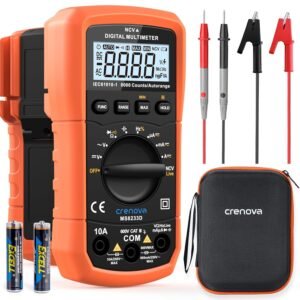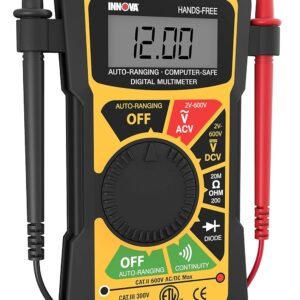Klein Tools ET600 Multimeter Review Comprehensive Insulation Tester with True RMS Accuracy
Klein Tools ET600 Multimeter Review Comprehensive Insulation Tester with True RMS Accuracy
- Measures insulation resistance up to 4000MΩ at multiple voltages (125V, 250V, 500V, 1000V) for thorough testing
- Equipped with a backlit display and bar graph that improve readability in various lighting conditions
- Automatic ranging True RMS technology provides highly accurate and reliable measurement results
- Includes warning alarm and high voltage icon to ensure user safety during electrical testing
As an Amazon Associate I earn from qualifying purchases.
Description
Highlights of the Klein Tools ET600 Megohmmeter Insulation Tester
Using the Klein Tools ET600 Multimeter, Megohmmeter Insulation Tester has been quite a journey, especially since it packs a lot into a single device. One standout feature is its ability to measure insulation resistance up to 4000MΩ at four selectable voltages: 125V, 250V, 500V, and 1000V DC. For someone like me who often deals with electrical diagnostics, this multimeter’s versatility is a huge plus. The inclusion of auto-ranging True RMS technology means I get accurate AC/DC voltage readings up to 1000V, which feels like a professional-grade touch, especially useful when working with tricky circuits where voltage fluctuations occur.
The lock function is a clever addition — it allows me to hold the measurement without continuously pressing the test button, which is super handy when both hands are busy. The backlit dual-function display with a bar graph and icons for Max/Min, Hold, and High Voltage makes reading results easy even in dimly lit spaces, like inside electrical panels or basements. It’s clear that the design was made with real-world electricians and DIYers in mind.
Drawbacks of the Device
Of course, no tool is perfect. The weight of 1.4 pounds might not sound like much, but after holding it during extended testing sessions, I noticed my arm getting a bit tired. The size, about 10 x 2 x 4.5 inches, makes it bulkier than some other compact multimeters, so it’s not as pocket-friendly as I’d hoped. I also found the battery life somewhat limiting; it runs on six AA batteries, which were included, but the device can drain them faster than I expected during heavy use. The low battery indicator is useful, yet frequent replacements can be inconvenient on long jobsites.
Another minor gripe is the learning curve with the various voltage settings. While the multiple test voltages are a boon, toggling between 125V, 250V, 500V, and 1000V DC requires a bit of attention to avoid mistakes, especially when rushing through insulation tests. Lastly, the warning alarm meant to detect voltage can occasionally be overly sensitive, giving false alarms around certain equipment, which can be a bit frustrating.
User-Friendly Features and Practical Applications
Hands-free operation is a real game-changer here. The built-in stand supports the device upright, freeing my hands during testing — something I genuinely appreciate when working alone. The standard CAT III/CAT IV safety-rated test leads with heavy-duty alligator clips add to the device’s reliability, making it easy to connect securely to wires and components without worrying about accidental slips.
I noticed my coworkers and even my kids were intrigued by the digital display and the audible alerts, though I wouldn’t recommend the device for casual home use due to its professional-level complexity. The continuity and resistance measurements complement the insulation testing, turning this into a multifunctional tool that can replace several others in my kit. It’s especially useful for troubleshooting motors, transformers, and wiring insulation integrity, giving me confidence that circuits are safe and functioning as intended.
Drawbacks for Consideration
- The device’s bulkiness can be a hassle when trying to carry it in a tight toolbelt or small bag.
- Battery consumption is on the higher side, so I often keep spare AA batteries handy.
- The sensitivity of the high voltage alarm sometimes leads to false positives.
- The manual toggling between voltage test settings requires careful attention to avoid confusion.
Competitive Options in the Market
Comparing this multifunctional tester to other well-known brands like Fluke and Extech, the Klein Tools model holds its own firmly in terms of insulation resistance testing capabilities and safety ratings. Fluke’s insulation testers often come with a sleeker design and sometimes better battery efficiency, but they tend to be pricier. Extech models offer simplicity and portability but may lack the broad voltage testing range that this device provides.
One edge for the Klein Tools ET600 is its dual-function backlit display and lock feature, which I didn’t find as intuitive on some competitors. However, if you need ultra-compact gear, other brands might suit better. For heavy-duty professional use, though, the Klein’s robust build and comprehensive voltage options give it a serious advantage in reliability and versatility.
Value for Money
Considering the multifunctionality, safety certifications, and accuracy provided by True RMS technology, this tester offers solid value for money. It’s not the cheapest tool on the market, but it’s designed to withstand the rigors of professional environments and deliver precise insulation resistance and voltage measurements, which justifies the investment. The inclusion of CAT III/CAT IV-rated test leads and a sturdy carrying case (if you get it as part of a bundle) adds to the overall package.
For anyone who needs an all-in-one tester capable of handling insulation testing alongside standard multimeter functions, this device is a smart buy. It saves you from juggling multiple instruments without sacrificing accuracy or safety. However, if your tasks are simpler or you prioritize portability over function, exploring cheaper or smaller alternatives might be worthwhile.
Usability and Interface Experience
The user interface combines buttons for testing, locking, and selecting voltage levels with an intuitive display that shows both numeric values and graphical bars. This makes it easier to interpret results quickly, especially when working in noisy or low-light environments. The auto-power-off feature helps conserve battery, which I found practical, although it occasionally turned off mid-use during longer measurements, requiring me to restart the process.
The warning icons and audible alerts contribute to safety by signaling the presence of dangerous voltages, but as mentioned earlier, the sensitivity could use some refinement. Overall, the device feels sturdy and well-built, with the familiar orange and black Klein Tools color scheme that stands out in a cluttered toolbox.
Versatility for Different Users
This tester is a solid fit for electricians, maintenance technicians, and serious DIY enthusiasts who need to verify insulation conditions and perform comprehensive electrical diagnostics. While my kids found it fascinating to play with the display, I’d caution against casual use because of the high voltages it can output during insulation testing. The multiple measurement capabilities including AC/DC voltage, resistance, continuity, and insulation resistance testing make it a versatile tool that can streamline many electrical troubleshooting tasks.
In summary, this tester impressed me with its robust functionality, safety features, and accuracy, although it comes with a few quirks like weight and battery life that might not suit everyone’s workflow. It holds its ground well against competitors and offers a package that balances professional-grade performance with user-friendly elements.
Additional information
| Brand | Klein Tools |
|---|---|
| Power Source | Battery Powered |
| Style | Tester |
| Color | Orange/Black |
| Item Weight | 1.4 Pounds |













